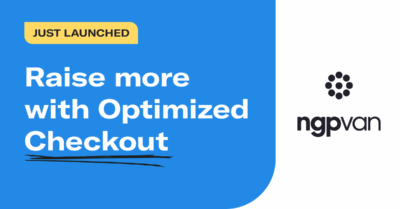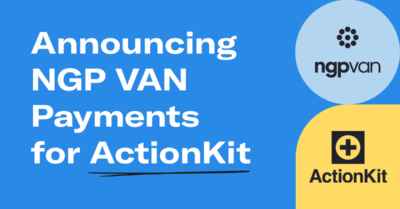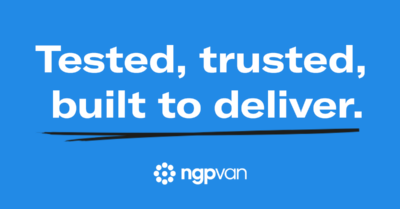How to run a grassroots political campaign

Grassroots organizing can play a powerful part in the success of political campaigns up and down the ballot. Whether you’re running an issue-based campaign or campaigning as a local candidate, mobilizing strong grassroots support could be the push that helps you win.
This guide will explore the basics of grassroots organizing and what it takes to run a political campaign on a foundation of grassroots support.
What is a grassroots campaign?
Grassroots organizing is when activists generate support and inspire action for a cause from the ground up. In the political sphere, this means that grassroots political campaigns rely heavily on the support of volunteers, local organizations, and everyday community members, rather than large donations and institutional support.
At their core, grassroots campaigns are all about community, prioritizing the average citizen and finding power in collective action at the local level. Some of the most historic victories have been powered by mobilizing community-based support for a candidate or issue.
Grassroots support does more than just help your candidate win — it can also inspire increased voter participation, cultivate trust in your candidate, and contribute to large-scale, lasting policy changes.
How to start a grassroots movement
Since grassroots political campaigns rely on gathering large numbers of passionate volunteers and advocates, you need a campaign plan to spread your message and inspire enough support. Follow these essential steps to start a powerful grassroots movement for your campaign.
Clarify your grassroots campaign’s message
Before you conduct outreach or even announce your campaign publicly, take time to develop messaging that will resonate with members of your target audience — which includes voters, donors, and volunteers.
You’ll refine your message over time as you learn more about voters’ priorities and the people involved in your grassroots movement. Still, it’s important to articulate the core vision of your campaign now. Address key issues that the public is passionate about, and craft statements that speak to community members’ most pressing concerns. This cohesive messaging should be the basis of your campaign’s online communications, emails, ads, and more.
Finally, make sure that your message is personal and empowering. Grassroots political campaigns are all about empowering everyday people to take action for the causes they believe in, and your message should reflect that. Focus on just a few important issues to start and add others as they arise. This will help supporters hone in on what’s important to your campaign.
Cultivate support within the community
Once you can articulate your grassroots campaign’s message, get out in the community and start making the connections that will drive your campaign forward. Introduce yourself to voters, learn more about the organizations within your community, and connect with influential leaders. Building support early will make it easier for your campaign to develop meaningful relationships with supporters and ask them to take action when you need them to.
Use the following methods to start building these crucial connections:
- Reach out to likely supporters of your candidacy through canvassing, phone banking, and other outreach methods.
- Tap into the networks of existing supporters to make new connections and expand your campaign’s reach further.
- Host in-person or virtual campaign events, town halls, and meet-and-greets to talk with community members and build relationships.
- Partner with local organizations that align with your campaign’s values and connect with their supporters.
- Participate in other public events like community service activities and festivals to build a public presence.
To understand just how effective these connections can be for mobilizing large amounts of grassroots support, revisit campaigns that have done it in the past. Remember how Democratic voters in Georgia helped boost Biden’s 2020 presidential campaign? This was largely thanks to the work of local activists like Stacey Abrams and organizations like Fair Fight and the New Georgia Project, which registered more than 800,000 voters.
Consider the ways that local leaders and organizations could support your grassroots political campaign, and put the work in now to build those relationships.
Fundraise strategically
Most grassroots campaigns are funded by a large number of small donations instead of gifts from major donors. However, most campaigns still employ multichannel fundraising outreach for all donors to help them raise more money so they can meet donors where they are and raise the resources they need in order to run competitive campaigns.
Focus your attention on securing donations of all sizes. Use fundraising strategies that will get the attention of everyday people and inspire them to give what they can, while still employing tried-and-true political fundraising techniques (like call time) to raise the money you need to win. Grassroots fundraising tends to involve:
- Call time: Call prospective and existing donors on the phone and ask them to give to your campaign. It’s one of the most effective ways to raise money, and it allows you to build more meaningful relationships with donors. Call time also allows you to address any concerns or questions from donors — something you cannot easily do through other fundraising methods.
- Fundraising emails: Send email appeals asking for donations of specific small dollar or targeted asks based on a donor’s previous contribution. Emphasize the power of small donations and how they can make a big difference for your campaign, and thank every donor who gives.
- Social media fundraising: Appeal for donations regularly on your campaign’s social media profiles, and consider using targeted Facebook or Instagram ads to get your campaign in front of new and existing supporters (depending on what your goals are).
- Fundraising events: In-person and online events are opportunities to connect with voters and donors while you fundraise. Use these events to convince guests to support your campaign both monetarily and by volunteering.
Small donations en masse can be powerful as they can show widespread support from a broad donor base, but prioritizing them shouldn’t come at the expense of missing other opportunities. You should still tap into every fundraising opportunity available to your campaign. If you identify major prospects within your fundraising CRM or if you have a strong relationship with PACs or group that may be willing to give to your campaign, add them to your call time list, send them a donation letter in the mail, or set up a meeting with them to secure their donations too.
Invest in political campaign technology
There are a variety of impactful tools you can use to support your fundraising efforts and mobilize volunteers.
Start with your campaign website, as this is the place interested voters, donors, and volunteers will likely go first to learn more about your campaign. Ensure that your website includes plenty of information about your candidate’s personal history and stances on key issues, then build out a “Take Action” page that provides information and easy steps supporters can take to help your campaign. Include links to sign up to canvass, attend events, and donate.
Then, explore other tools like canvassing apps, fundraising and compliance databases, voter file solutions, and digital outreach platforms that simplify work for both your campaign team and your volunteers. In an increasingly digital world, it’s important to build a tech stack that can help you keep up with the times and run the best campaign you can.
Empower volunteers to advocate for your campaign
The final and most important step in any grassroots campaign is to empower your volunteers to act. Your supporters will be instrumental in spreading the word about your campaign, convincing voters to get to the polls, and keeping up your grassroots movement’s momentum.
Additionally, many grassroots political campaigns utilize distributed organizing models instead of a traditional campaign structure to offset costs, decentralize power, and encourage community collaboration. These models give volunteers more responsibility and agency by having them lead small chapters of volunteers that work together to propel your campaign forward. Whether your campaign uses distributed organizing or not, you’ll need to use the following methods to boost your advocacy efforts:
Digital outreach
Create a digital campaign strategy that leverages multiple communication channels to connect with voters, donors, and volunteers.
SMS (text messages) and social media can be particularly effective for mobilizing volunteers. Use social media to prompt followers to take action for your campaign by signing up to canvass or phone bank, then stay in regular contact with the volunteers who sign up and work to re-shift them after they complete their shifts. Send them all the information they need to participate, and make a lead volunteer or member of your campaign team available to answer questions and provide support.
Canvassing
Door-to-door canvassing is a tried and true method for persuading and mobilizing voters to vote for your candidate. Host frequent canvassing events and give your volunteers all the resources they need to effectively promote your campaign, like scripts, campaign literature, and maps of targeted voter households. Or, use canvassing software to empower volunteers to canvass on their own time, whenever it’s most convenient for them.
Phone banking
In addition to knocking on doors, ask volunteers to call voters by participating in phone banking. Speaking with voters over the phone helps your campaign gather information while mobilizing voters to support your campaign. Create targeted call lists using voter data, then write scripts for volunteers to use for a variety of situations. Similar to canvassing, you can host organized phone banking events or encourage volunteers to call voters on their own through virtual phone banking.
Voter registration drives
Register new voters and boost political participation in your community by having volunteers run voter registration drives. Make sure you and your volunteers know all the relevant laws and deadlines related to voter registration before you host a voter registration drive so you can provide accurate information to those new voters.
Grassroots political campaign tips
Running a grassroots political campaign effectively can be a challenge, so follow these final tips to give yourself the best chances of success:
- Build a diverse coalition of support. Convince more people to join your grassroots movement and vote for your candidate by building relationships with supporters from diverse backgrounds. When you have diverse voices backing your campaign, you’ll be better equipped to speak to all the groups in your community and connect with them.
- Learn about public opinion from your voters. Ask every voter a few questions to give you insight into what issues matter most to the voters in your jurisdiction. Learn from their personal motivations and the issues they care most about and speak about how you’d plan to address those issues when elected. Make sure to track their responses in a voter database to act on that data in the future.
- Make it as easy as possible to participate. Do everything you can to simplify work for your volunteers and create a positive experience that makes them want to come back and help again. This includes designing hassle-free registration forms, providing them with scripts for canvassing and phone banking, and leveraging your campaign tools to make volunteering easy.
When in doubt, listen to the voters and your supporters. They’re the key to understanding public opinion, generating more support, and your campaign’s success. Remember that community members are the primary driving force behind your campaign, and prioritize them accordingly.
How to run a grassroots political campaign with NGP VAN
Starting a grassroots movement for your campaign can be incredibly rewarding, but it may also feel overwhelming, especially if you have a small team or limited experience. Fortunately, there are plenty of tools available to help you mobilize support for your campaign, like those provided by NGP VAN. Explore our software to learn how NGP VAN can help you mobilize the grassroots support you need to win.



